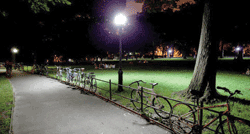With better analysis, the benefits of using LEDs for street lights are now becoming clear to more government groups
BY RICHARD COMERFORD
Editor
While much of the media and lighting industry’s focus in the past year has been on replacing household lighting with more efficient light sources, a trend that started over five years ago using solid-state light sources for municipal lighting is now taking strong hold. Help in analyzing benefits is leading to new examples of implementations popping up every month.
In late 2006, Raleigh officials converted one floor of a municipal parking garage to LED lighting to test light quality, energy use, and consumer reaction. The result was a 40% energy savings, and Raleigh utilities provider Progress Energy noted that light quality was greatly improved. Two hundred garage users were before and after the LED lighting was installed, and positive reactions to the garage’s lighting after LEDs were installed were three times higher. Further, 74 % of the respondents felt that safety was significantly enhanced.
“The economic benefits for municipalities to invest in LEDs are clear — they save energy, reduce environmental impact, and improve the quality of light,” states Mayor Charles Meeker. “We believe that the cost savings and benefits of LED lighting are real and achievable today.”
Bright LEDs, big cities
As a result, The LED City program was launched as a joint effort by Cree and the City of Raleigh, NC, in February 2007. Since then, notes Dan Howe, Raleigh assistant city manager, “We have completed upwards of 25 LED lighting projects. We are moving forward with LED lighting whenever we can, including three solar-powered LED pole-lighting projects in places where line power is unavailable.” (See www2.electronicproducts.com/L-article-farccree_may 2008-html.aspx)
More recently, The City of Boston joined the LED City program, which now numbers 25 cities throughout the world as members. According to the city’s website, Boston has 64,000 electric street lights, which use 65,000,000 kWh and cost $8 million annually.
In December 2010, the city’s Street Lighting Division began converting mercury vapor and sodium lamps to LED. A year later, the city had decreased it’s electric use for street lighting by 5.1-million kWh. By the end of 2012, it will have installed 23,000 LEDs. This will save $2.8 million annually, and the City of Boston plans to continue with more conversions in 2013.

New York City has recently tested LED street lighting in Central Park.
On the dark side
Although many municipalities have had success installing solid-state street lighting, the finding of a test sponsored by the U.S. Department of Energy — Assessment of LED Technology in Ornamental Post-Top Luminaires — Host Site: Sacramento, CA — that were released in December 2011 clearly show that conversion is not to be undertaken lightly.
Conducted in Sacramento, CA, starting in March 2011, the test used three lamp-ballast replacements selected by the city, in coordination with manufacturers and their sales reps, as well as an LED luminaire selected by Pacific Northwest National Laboratory (PNNL) to represent best-in-class LED performance for this project.
PNNL created a computer model using manufacturer-provided photometry and predicted that none of the LED products would match the photopic performance of the existing 100-W high-pressure sodium (HPS) luminaires. Measurements not only verified none of the LED products matched the initial light levels produced by the existing HPS luminaires, but also confirmed two of the LED products greatly reduced the uniformity of illumination.
Thus the study found that any energy savings from the LED products examined were directly attributable to reduced photopic light levels. Further, the report said that the performance gap between HPS and LED luminaires widened when light loss factors were considered. In conclusion, it said that, “The results indicate the four LED products evaluated would not represent cost-effective replacements for the existing HPS.”
Light at the tunnel’s end
Fortunately for the lighting industry, it moves swiftly, if not quite at the speed of light. Since the study was conducted, newer lighting with higher brightness and efficiency has become available, as have new Department of Energy (DOE) methods for evaluating lighting effectiveness.
In September 2012, the DOE published Demonstration Assessment of LED Post-Top Lighting Host Site: Central Park, New York City. In this case, the study found that, of the five luminaires tested, three “cost effectively reduced energy use and met or exceeded measured illuminance values relative to the metal halide baseline.
Several other studies recently released by DOE have produced similar results. ■
Advertisement
Learn more about Electronic Products Magazine





